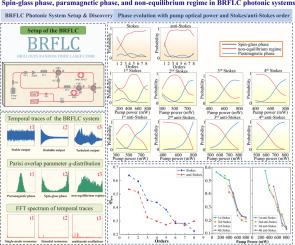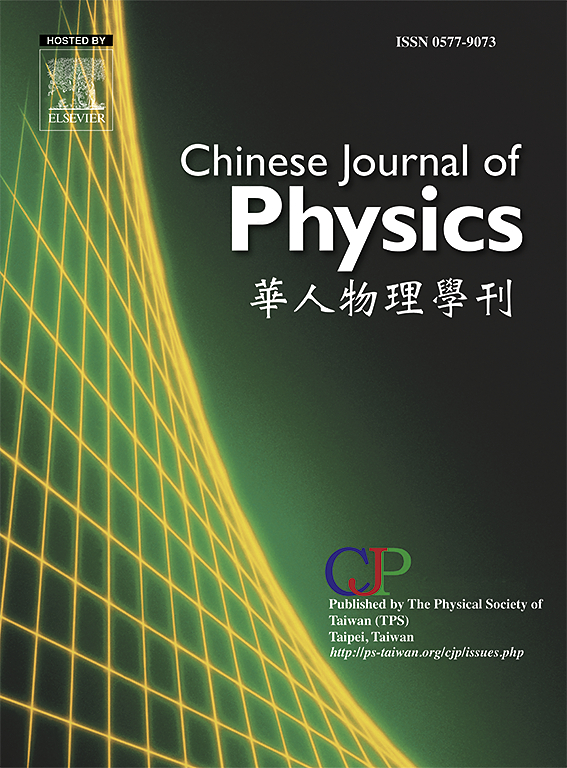Observed photonic phase evolutions in Brillouin random fiber laser comb
IF 4.6
2区 物理与天体物理
Q1 PHYSICS, MULTIDISCIPLINARY
引用次数: 0
Abstract
We report the experimental demonstration of photonic phase transitions in a Brillouin random fiber laser comb (BRFLC) through a spin-glass theoretical framework in photonic systems. By systematically analyzing the statistical distribution of the Parisi overlap parameter q across different Stokes/anti-Stokes orders and pump powers, we identify three distinct photonic phases. The paramagnetic phase, characterized by a P(q) distribution peaked near zero, reflects uncorrelated intensity fluctuations and corresponds to the selective amplification of a single resonant mode in the cavity. In contrast, the spin-glass phase, marked by q-values concentrated at ±1, signifies strongly correlated or anti-correlated dynamics, arising from the interaction of dual resonant modes. Crucially, the transition between these phases is governed by the number and lifetimes of interacting optical resonance modes. Bimodal resonance triggers replica symmetry breaking (RSB), driving the system to evolve from the paramagnetic to the spin-glass phase. Beyond this, multimode oscillations induce a non-equilibrium regime which mirrors the frustration-induced multi-step RSB process observed in disordered spin systems. It corresponds to a broadened P(q) distribution that defies conventional phase classification and reveals a complex photonic state with hierarchical correlations. As the number of modes continues to increase and the mode lifetimes become anomalously short, the dominant resonant mode in the cavity eventually disappears. This transition causes the statistical distribution of the corresponding overlap parameter q to converge to a Gaussian-like profile, indicating that the system has once again returned to a disordered paramagnetic phase. Our work establishes BRFLC as a controllable platform to emulate spin-glass physics in photonics, enabling direct access to phase dynamics through tunable disorder and mode competition. The discovery of the photonic phase evolutions helps to reveal the underlying physical mechanism accounting for the BRFLC operation and contributes to the understanding of complex synergistic nonlinear physical processes in random fiber lasers.

布里渊随机光纤激光梳中光子相位演化的观察
本文利用自旋玻璃理论框架,报道了布里渊随机光纤激光梳(BRFLC)中光子相变的实验证明。通过系统分析不同Stokes/反Stokes阶和泵浦功率下的Parisi重叠参数q的统计分布,我们确定了三个不同的光子相位。顺磁相位以P(q)分布为特征,峰值接近零,反映了不相关的强度波动,对应于腔中单个谐振模式的选择性放大。相反,自旋玻璃相的q值集中在±1,表示由双共振模式相互作用产生的强相关或反相关动力学。至关重要的是,这些相位之间的跃迁是由相互作用的光学共振模式的数量和寿命决定的。双峰共振触发复制对称破缺(RSB),驱动系统从顺磁相进化到自旋玻璃相。除此之外,多模振荡诱导了一个非平衡状态,反映了在无序自旋系统中观察到的挫折诱导的多步RSB过程。它对应于一个加宽的P(q)分布,这违背了传统的相位分类,并揭示了具有层次相关性的复杂光子态。随着模态数的不断增加和模态寿命的异常缩短,谐振腔中的主导谐振模最终消失。这种转变导致相应的重叠参数q的统计分布收敛到一个类高斯分布,表明系统再次回到无序的顺磁相位。我们的工作建立了BRFLC作为一个可控的平台来模拟光子学中的自旋玻璃物理,通过可调无序和模式竞争可以直接访问相动力学。光子相位演化的发现有助于揭示BRFLC运行的潜在物理机制,并有助于理解随机光纤激光器中复杂的协同非线性物理过程。
本文章由计算机程序翻译,如有差异,请以英文原文为准。
求助全文
约1分钟内获得全文
求助全文
来源期刊

Chinese Journal of Physics
物理-物理:综合
CiteScore
8.50
自引率
10.00%
发文量
361
审稿时长
44 days
期刊介绍:
The Chinese Journal of Physics publishes important advances in various branches in physics, including statistical and biophysical physics, condensed matter physics, atomic/molecular physics, optics, particle physics and nuclear physics.
The editors welcome manuscripts on:
-General Physics: Statistical and Quantum Mechanics, etc.-
Gravitation and Astrophysics-
Elementary Particles and Fields-
Nuclear Physics-
Atomic, Molecular, and Optical Physics-
Quantum Information and Quantum Computation-
Fluid Dynamics, Nonlinear Dynamics, Chaos, and Complex Networks-
Plasma and Beam Physics-
Condensed Matter: Structure, etc.-
Condensed Matter: Electronic Properties, etc.-
Polymer, Soft Matter, Biological, and Interdisciplinary Physics.
CJP publishes regular research papers, feature articles and review papers.
 求助内容:
求助内容: 应助结果提醒方式:
应助结果提醒方式:


